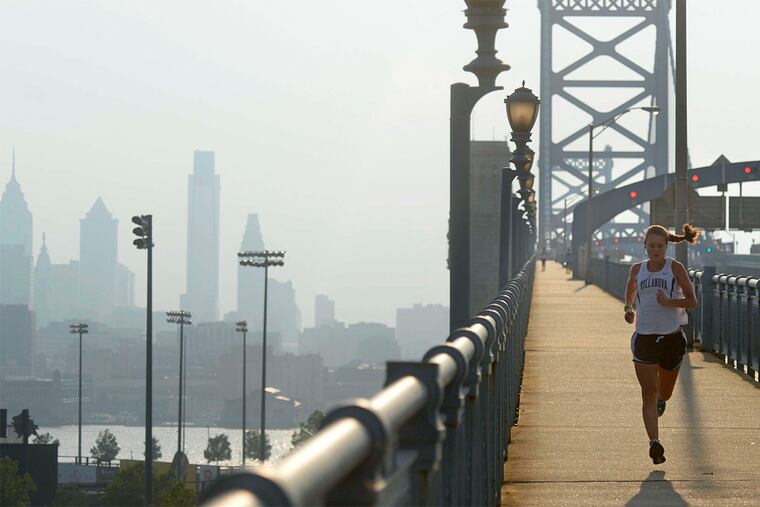Connecting with the Ben Franklin Bridge, step by step
When the Delaware River Bridge opened on July 1, 1926, an estimated 100,000 people crossed the span, taking the opportunity to travel between Philadelphia and Camden without water transportation.

When the Delaware River Bridge opened on July 1, 1926, an estimated 100,000 people crossed the span, taking the opportunity to travel between Philadelphia and Camden without water transportation.
They came on foot, not by car, that first day.
Ninety years later, the bridge has undergone many changes, starting with its name. The span was renamed the Benjamin Franklin Bridge in 1956 to differentiate it from the Walt Whitman Bridge. Tolls are now one-way and have risen from 25 cents to $5 for cars, with E-ZPass now an option. A horse and rider could have crossed the bridge for 15 cents, while a horse-drawn carriage had a toll of 30 cents in 1926.
Pedestrian access has remained a constant, a fixed point in a changing age. The Ben Franklin is the only one of the four bridges operated by the Delaware River Port Authority with that option.
After living in South Jersey for 60 years, I walked across the bridge for the first time with Maria, my older daughter, on an overcast Sunday afternoon in late May.
On the Camden side, we go through an underground pedestrian tunnel and climb about 40 steps to reach the bridge's south walkway. The north walkway is primarily used for bridge operations and is generally closed to the public, says DRPA spokesman Mike Williams.
As we start out, a call box with a sign and phone number for a Suicide Prevention Life Line catches our eyes. It's a sobering reminder that this has been the final walk for some people. Another sign warns that roller skating, inline skating, and skateboarding, as well as motorcycling, are prohibited on the walkway.
We quickly see the bridge attracts its share of joggers, runners, and bicyclists.
"I run here three to four times a week," says Uri Halle, a jogger in his mid-20s from Cherry Hill. "You can't beat the view."
Echoing that viewpoint are Marius Gavin and his wife, Ann. They traveled from their home in County Westmeath, Ireland, to visit their son in Philadelphia and decided to visit the Ben Franklin. "The bridge is fantastic," he says, pausing to photograph some river scenes.
The view is a special one, especially since Maria and I can take our time and get a close-up look at the river and the waterfront with the help of binoculars. To the south, the Walt Whitman is clearly visible. Looking north, the Betsy Ross Bridge can be seen in the distance. In between those two landmarks are Campbell's Field, home of the former Camden Riversharks; Adventure Aquarium; and the Battleship New Jersey Museum and Memorial. Nearly 900 feet long, the stationary battleship provides a sharp contrast to the sailboats that maneuver near it.
The walk engages all our senses. About 165 feet up near the bridge's midway point, we can see a sailboat crew from the Liberty Sailing Club lower its sail, switch to motorized power, and return to its dock in Philadelphia. An eastbound PATCO train rumbles beneath our feet as it heads to its stops in Camden while bridge traffic stops and starts, occasionally punctuated by the sound of a car horn. Closer to Philadelphia, traffic on I-95 comes into view and a city police car with flashing lights picks up speed along Race Street on its way to a call. The occasional light breeze is refreshing.
Designed to handle emergencies, the walkway is wide enough to accommodate a DRPA police car that has stopped ahead of us. Standpipes provide access to water in case of a fire on the bridge.
Traveling by car, it's easy to take the bridge for granted. As a walker, I gain a new appreciation for the engineering and skill required to make the 61,700-ton structure a reality. The size is also impressive. From the top of the highest bridge tower to the river is 380 feet, Williams says.
Construction on the 8,300-foot-long bridge began Jan. 4, 1922, and cost $37,103,765.42, according to the DRPA. There also was a human cost in this mammoth undertaking. A plaque on the Philadelphia side of the walkway reminds all who pass it with a simple inscription: "In memory of those who lost their lives in the building of this bridge." Thirteen men died during the construction and two other workers died after the bridge opened, Williams says.
After reaching the Philadelphia side, Maria and I turn around and return to Camden and our car parked on Cooper Street. The journey of about three miles has been one to remember. There is no toll for walking across the bridge, a policy that hasn't changed in 90 years. Maybe this is the original Easy Pass.
For more information about walking the bridge, visit www.drpa.org.